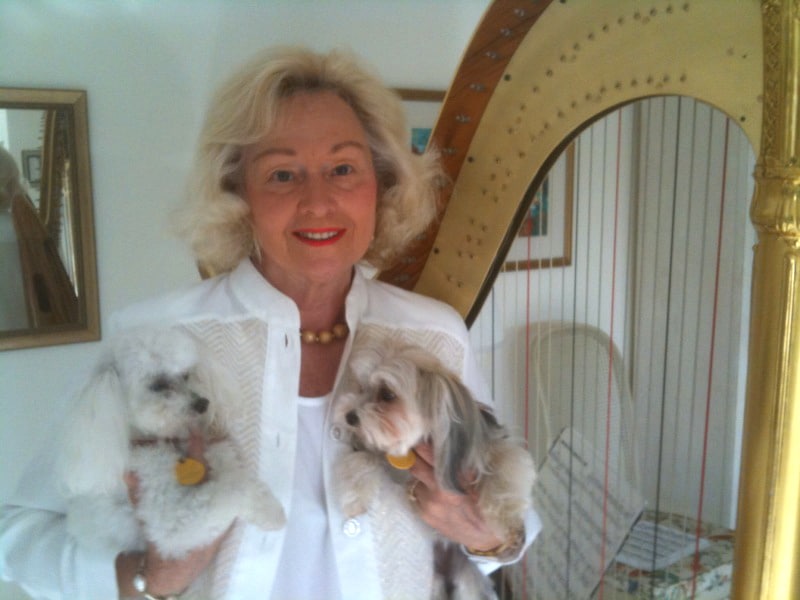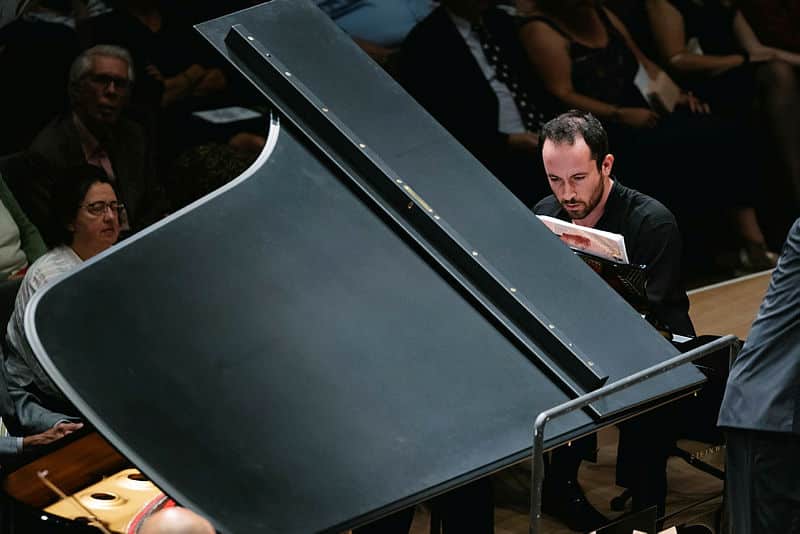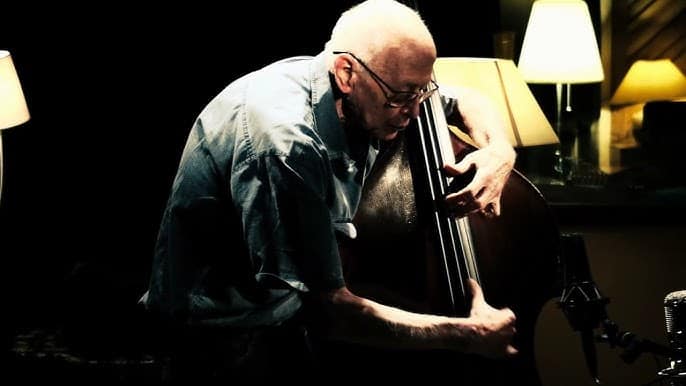Harp world engages in battle for the crown
mainFrom a plucky insider plucker:
Here’s a rare opporunity to peer into the arcane world of the harp.

As the “empress” Susann McDonald (pictured) retires from the University of Indiana, the world will see how fairly the succession process is handled. Will it be her hand-picked proteges, or a spectrum of the best? Will they dare to hire someone who would offend her or her students?
The job has been posted, though not advertised. They are already inviting her ex-pupils as guest teachers. This is a public university with legal responsibilities. But no one outside the harp world ever cares enough to ensure fair play.
If it is fair, they will invite, at least, Yolanda Kondanassis (Cleveland Inst. of Music and Oberlin), Joan Holland U of Mich. and Interlochen), Elizabeth Richter (Ball State U.), pupils of Lawrence and Chalifoux, who were pupils of Salzedo, whose legacy McDonald overturned. And the greatest living harpist, Heidi Lehwalder, Salzedo’s own protege, will she be considered?
And what will happen at the Curtis Institute if Elizabeth Hainen is hired in Bloomington? Big changes are in the offing, and scandalous results seem almost guaranteed. The University in Graz is also hiring a professor of harp. With only two openings in the whole world, after years of no openings, who will win the crown? Note that virtually all University and college harp professorships in the US have been reduced to adjunct (hourly) positions, after there once being dozens of such jobs. It is a dismal time, indeed.





Don’t get me started, Norman. The battle that I contended with was always Salzedo vs. Grandjany. Elizabeth Hainen has roots in both camps, I believe. I know her personally and she is fine player and a caring pedagogue.
I shall now retreat to a safe place while the battle commences. Harpists are sometimes not so angelic!
You and me both, Bob. See you in a darkened Montmartre bar.
I feel compelled to respond. Harpists are not “arcane.” Most of today’s players—including many named in your post—have dropped the “Salzedo vs. Grandjany” thing, so please do us all the favor of not perpetuating this outdated stereotype.
We’d also like to point out that the photo in your post—no doubt chosen to illustrate your smug use of the word “empress,” was obviously taken directly from http://www.harpcolumn.com, where we suggest your readers go to obtain real news about the harp. While we think Ms. McDonald looks fabulous in any shot, one of the many professional photos of her readily available online would no doubt be more befitting of someone of her stature.
Sincerely,
Kimberly Rowe,
founder and web editor at Harp Column
Yours is a great response to cheap journalism. Brava!
Well said, Kim
Thank you, Kim!! This was a ridiculous article, and your reply was excellent and needed.
Thank you, Kim! Also, one minute of research would reveal that the institution in question is Indiana University, not the mysterious and nonexistent “University of Indiana.”
Round here, there is no difference between Cambridge University and the University of Cambridge. These sensitivities are indicative of the level of harp debate.
Ms McDonald is professor of harp at the Jacobs School Music of Indiana University, Bloomington. In the arcane world of American musical higher education, it’s often simply called “Indiana” and most people know what that means. Another moniker is simply “Bloomington.” More recently folks have become accustomed to saying “Jacobs” meaning the full title stated at the beginning of this reply. Please forgive my pedantic musings.
That’s totally ridiculous. Do you also call the University of Massachusetts Massachusetts University? It’s interesting to note that the sports world hardly ever gets the name wrong. What a shame that an arts blogger can further undercut the relevance of the arts by being so uninformed.
Well said!
At the very first International Harp Competition held in Israel in 1959, Annette Vito – daughter of Toscanini NBC harpist Ed Vito and niece of Chicago Symphony harpist Joe Vito – didn’t make the final round although she played better than many who did. She was neither a Grandjany nor a Salzedo pupil – both judges. McDonald placed 2nd in what I thought were technically secure but boring performances. Disclaimer: my wife at the time was also a contestant who made the finals.
As the Philadelphia Orchestra’s principal harp, Liz Hainen is as good as they come. An appointment to IU would be a huge conflict.
It is actually Indiana University, as the University of Indiana is different.
Quite frankly many of the younger harpists these days far outshine either Salzedo or Grandjany, and technique has evolved and improved greatly over the past fifty years, making your blanket statements about respective harpists’ merit based on lineage tenuous at best.
With so many amazing harpists working today it is virtually impossible to say who is the greatest among them. One name they should consider is Sarah Schuster Ericsson, a student of Chalifoux and former Assistant Principal Harp of the Boston Symphony Orchestra. Additionally, I believe she is the only harpist ever nominated for a Grammy. No doubt there are other deserving names available, which means that UI has some intense and pleasurable work ahead in filling its vacancy.
Thank you, Kim for speaking on behalf of so many of us.
Mary Jane D’Arville
Remarkable. First the “story” was plagiarized in whole from the tipster. Then the commenters go on to display the kind of ignorance that plagues the harp. There are no more than two or three harpists alive today who can play as well as Salzedo, and few as expressive as Grandjany. The young players who ignore the traditions established by these giants suffer for their ignorance and are boring, mediocre performers. The only difference is that the level of the worst playing has risen considerably, much like other instruments and singers, but the best level has dropped, if anything. Taste remains lacking, and repertoire is utterly lacking in interest to serious listeners or musicians. And an administrator or panel cannot make a wise decision while viewing all this as mere politics or infighting. While Hainen has forged a high profile as a solo performer while maintaining an orchestral position, she does not meet the standard of her predecessor, Marilyn Costello, or some others. Standards have basically dropped. Those who pursue success the easy way and cater to the most-popular or lowest common denominator bear responsibility for this as much as anyone.
There are two harpists in the world who play as well as Carlos Salzedo, Heidi Lehwalder and Alice Giles, and none who play as artistically and expressively as Marcel Grandjany. To say that young harpists today play better than any predecessors, is to say that sperficial mediocrity is the new gold standard. There are many harpists who can play fast, but far fewer that play musically. Nor are they gifted composers as well.
Failing to grasp the teaching of the masters is a sure way to be boring. No musicians should ever forget the greatest, or they will lose the path to excellence. Exceptional geniuses are just that, and remain so for eternity. Musicians and music lovers will continue to overlook the harp and harpists, as long as their mediocrity serves to justify it.
If administrators do not bother to understand the esthetics of harp playing and the differences between schools, and those of no school, then they can certainly be expected to make mediocre choices.
These are not stereotypes, they are reality.
Still no word as to who has been hired, or if the search goes on. It will be fairly outrageous if an American isn’t hired, given the paucity of such positions in this country, and that European schools will not hire Americans, as it seems. With school starting in a few months, one has to wonder. Will students even return if they don’t know with whom they’ll be studying? Hopefully, the search has been extended another year so it can be properly thorough and objective.
Thank you for speaking up! This “battle” is long gone. Everyone seems to forget that ALL of them started in the same school of playing. Hasselmans in Paris. Then they branched out and made their own way. As any good musician should. Music at all levels is about growth. Horrible article Unflattering picture. Susan deserved better.
This is the funniest “insider edition” of the “harp world.” It is too bad there are so few full-time positions left in the academia.
From 30some to less than ten. Yes, indeed. It makes it tragic for yet another foreigner to be hired instead of a more-qualified American. Perhaps her visa will be denied.